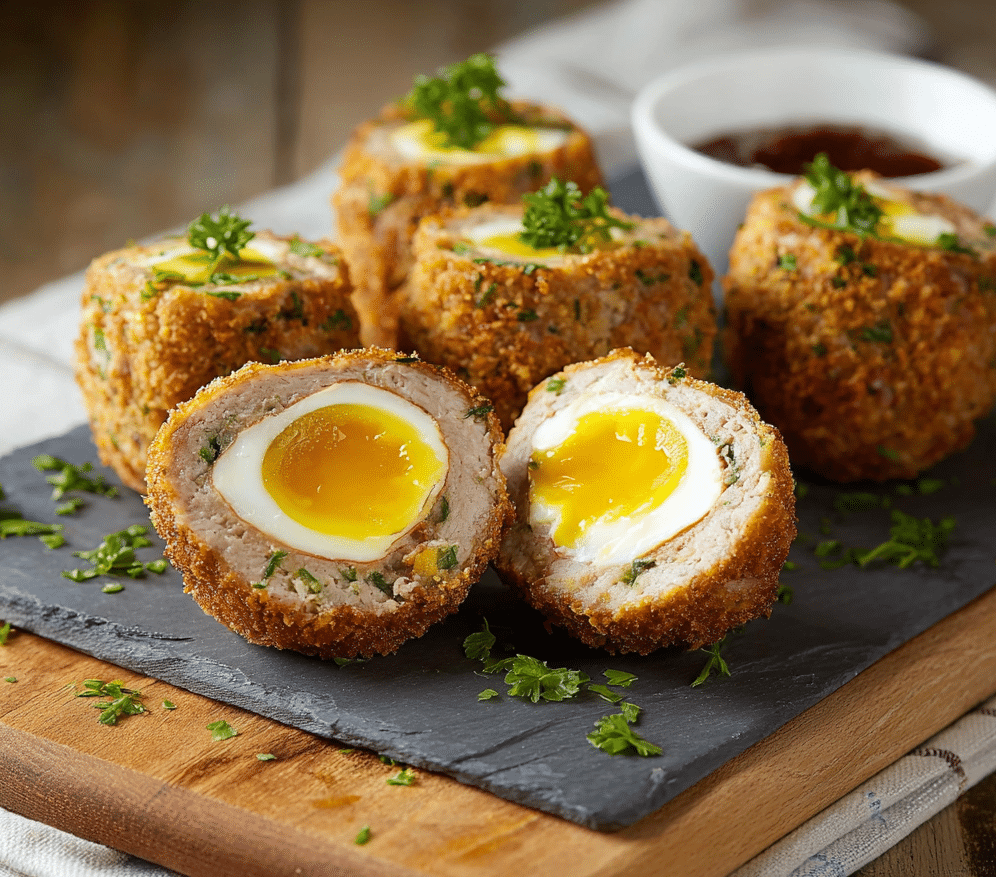These Scotch Eggs combine the heritage of classic British pub fare with vibrant flavors and the satisfying contrast of textures—from a crunchy golden crust to a tender, juicy pork layer and soft, creamy yolk. Perfectly portable, they’re tailor-made for picnics, parties, and casual gatherings.
Crafted with simple yet high-quality ingredients like fresh herbs, mustard, and panko, this recipe celebrates tradition while offering tips for best results—like chilling the meat-wrapped eggs to ensure even cooking and crispiness. Whether served warm or cold with mustard, chutney, or a fresh salad, these Scotch Eggs promise indulgent comfort and timeless appeal.
Full Recipe
Ingredients:
-
6 large eggs
-
500 g high‑quality pork sausage meat (skins removed)
-
1 tbsp Dijon mustard
-
1 tsp Worcestershire sauce
-
2 tsp fresh chopped parsley
-
1 tsp chopped thyme
-
¼ tsp ground mace
-
Salt & freshly ground black pepper
-
½ cup plain flour, seasoned
-
2 eggs, beaten with 2 tbsp milk
-
1 ¼ cups panko breadcrumbs
-
Vegetable oil for deep‑frying
Directions:
-
Soft‑boil 6 eggs in simmering water for 6 minutes; plunge into ice water, cool and peel.
-
Mix sausage meat, mustard, Worcestershire, herbs, mace, salt & pepper until well combined, then divide into six equal portions.
-
Flatten each portion, wrap around a peeled egg, sealing completely.
-
Refrigerate for 30 minutes to firm the meat casing.
-
Set up three bowls: seasoned flour, egg wash, panko. Dredge each scotch egg in flour, dip in egg wash, then coat with panko.
-
Heat oil to 160 °C; deep‑fry eggs in batches for 6–8 minutes until golden brown and cooked through. Drain on paper towels.
-
Serve warm or cold alongside mustard, chutney or piccalilli.
Prep Time: 25 minutes | Cooking Time: 20 minutes | Total Time: 45 minutes
Kcal: approx. 550 kcal per serving | Servings: 6 eggs
Introduction to Classic Scotch Eggs
Scotch eggs are a beloved staple of British culinary tradition. Featuring a soft- or hard-boiled egg encased in seasoned sausage meat, coated in breadcrumbs, and deep-fried or baked to a golden crisp, this hearty snack bridges the gap between comfort food and gourmet finger fare. They are as suitable for a rustic countryside picnic as they are for a high-end gastropub appetizer. With roots dating back to 18th-century London, the Scotch egg has evolved over the centuries, incorporating a variety of regional and international influences while still holding firm to its classic identity.
While traditionally served cold, often with mustard or pickles, modern renditions now range from spicy chorizo coatings to vegetarian alternatives made with falafel or lentils. The beauty of the Scotch egg lies in its flexibility and the contrast of textures—crunchy, creamy, and savory all in one bite.
Historical Background and Origin
There are several theories about the origin of the Scotch egg. One widely held belief is that it was invented by Fortnum & Mason, the renowned London department store, in 1738. Their version was designed as a convenient, high-protein travel snack for wealthy travelers. Others argue the dish may have descended from Indian nargisi kofta, a Mughlai creation brought to Britain during colonial rule, which also features a boiled egg wrapped in spiced meat.
Despite the ambiguity of its origins, what’s clear is that the Scotch egg quickly became popular in Britain, particularly as a picnic item and pub favorite. Its portability, simplicity, and robust flavor profile made it an instant classic.
What Makes a Perfect Scotch Egg?
Several components come together to define a truly exceptional Scotch egg. First, the egg yolk should be perfectly cooked—ideally slightly jammy and golden. This requires precision during the initial boiling phase and an immediate plunge into ice water to stop the cooking process. The sausage layer should be well-seasoned and balanced, incorporating herbs, spices, and sometimes a touch of mustard or Worcestershire sauce to elevate its depth. The outer layer must be crisp, using fresh breadcrumbs like panko to deliver the signature crunch.
Frying at the correct oil temperature is crucial. Too hot and the breadcrumbs burn before the meat cooks through; too cool and the eggs become greasy. Deep-frying is traditional, but some modern takes involve baking or air-frying for a lighter approach without sacrificing the texture.
Regional and Global Variations
Though rooted in British cuisine, Scotch eggs have taken on many regional adaptations. In the UK, they’re found everywhere from supermarkets to high-end eateries, with chefs often incorporating luxury ingredients like black pudding, truffle oil, or duck eggs. In Scotland, some versions include haggis in the sausage mixture.
In the U.S., Scotch eggs have found a niche in gastropubs and food trucks. American versions often go bold, using spicy sausage blends or dipping sauces like sriracha mayo or bourbon mustard. Vegetarian and vegan versions are increasingly popular, using lentils, mushrooms, or tofu to replace the meat, making the dish accessible to a broader audience.
Meanwhile, countries in Asia have been inspired by Scotch eggs to create similar dishes. In Japan, a version known as “nikumaki tamago” is a meat-wrapped egg glazed in a sweet soy sauce, and in the Philippines, a similar snack is known as “kwek-kwek,” though typically made with quail eggs and an orange batter.
When and How to Serve Scotch Eggs
Scotch eggs are extremely versatile. They can be served hot, warm, or cold. Cold Scotch eggs are typically enjoyed at picnics or as part of a traditional ploughman’s lunch, accompanied by sharp cheddar, pickles, crusty bread, and chutney. When served warm, they become an elevated appetizer or main dish, especially when paired with a side salad, roasted vegetables, or creamy mashed potatoes.
For breakfast, a halved Scotch egg is a protein-packed addition to a hearty plate. As party fare, mini Scotch eggs (often made with quail eggs) offer bite-sized elegance and are perfect for hors d’oeuvres. For a modern brunch table, Scotch eggs served with hollandaise or atop a waffle might just steal the show.
Tips for Best Results
Achieving perfect Scotch eggs takes practice and precision. Here are a few expert tips to ensure the best outcome:
-
Egg Timing: For that coveted jammy center, boil large eggs for exactly 6 minutes and transfer immediately to ice water.
-
Chill Before Frying: Once wrapped in sausage, chill the eggs for at least 30 minutes. This firms the meat and helps them hold their shape while frying.
-
Use Panko Breadcrumbs: Panko offers a light, airy crunch that elevates the texture.
-
Don’t Overcrowd the Oil: Fry in small batches to maintain oil temperature and achieve an even, golden finish.
-
Drain Well: After frying, place the eggs on a wire rack or paper towel to remove excess oil and preserve crispiness.
Pairing Suggestions
Scotch eggs pair beautifully with a range of beverages and sides. For drinks, a classic English ale or stout complements the savory richness of the dish. For something lighter, sparkling water with lemon or a citrusy white wine can cut through the fat and cleanse the palate.
As for sides, tangy pickles, pickled red onions, or a zesty arugula salad can balance the flavors. For a more robust meal, consider pairing with roasted root vegetables, coleslaw, or a slice of homemade sourdough bread.
Storing and Reheating
Scotch eggs are ideal for meal prep and store well. Refrigerate them in an airtight container for up to 3 days. To reheat, avoid the microwave if possible, as it softens the crispy coating. Instead, warm them in a 350°F (175°C) oven for 10–12 minutes or in an air fryer for about 5–6 minutes until heated through and crispy.
Freezing is also an option. Wrap them individually and freeze. When ready to eat, thaw in the refrigerator overnight, then reheat as usual.
Nutritional Value
While Scotch eggs are undeniably indulgent, they also pack nutritional value. A single serving contains a good dose of protein, making them a filling snack or meal component. They also provide iron, B-vitamins, and essential fats. Lighter versions can be made by baking instead of frying, using lean turkey sausage, or even opting for vegetarian alternatives to cut down on saturated fats.
Why Scotch Eggs Remain Popular
The continued popularity of Scotch eggs stems from their adaptability and satisfying nature. They’re nostalgic for many, evoking memories of school lunches, holiday picnics, or Sunday pub visits. Yet, they’re constantly being reimagined in creative ways that reflect global palates and dietary needs.
From humble beginnings as a travel snack to a centerpiece of modern brunch boards, Scotch eggs have proven themselves more than a culinary relic. Their robust flavor, visual appeal, and handheld convenience make them a lasting favorite across generations and continents.
Conclusion
Scotch eggs are more than just a boiled egg wrapped in sausage—they are a celebration of texture, flavor, and history. Whether served as a rustic snack, a classy appetizer, or a unique breakfast offering, they provide a sense of comfort and indulgence. Their enduring legacy in British food culture, combined with global reinterpretations, cements their status as a culinary icon. With a few simple techniques and quality ingredients, anyone can recreate this pub favorite at home and make it their own.
Scotch eggs invite creativity—whether you stick to tradition or experiment with ingredients, they’re a guaranteed crowd-pleaser that deserve a spot in your recipe collection.






